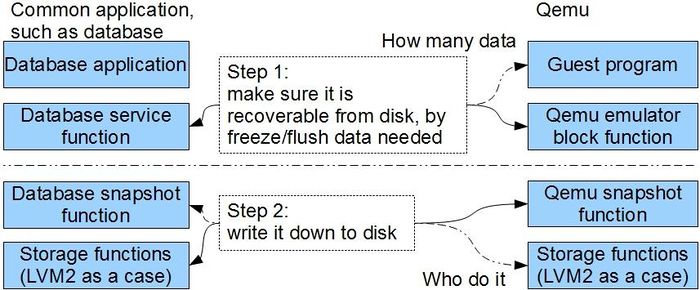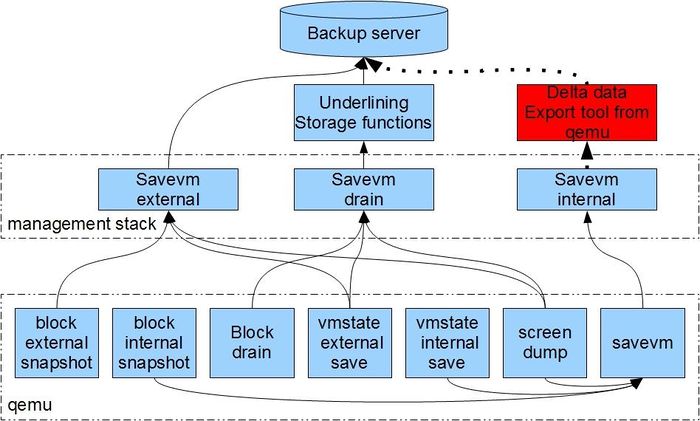Features/VMSnapshotEnchancement: Difference between revisions
No edit summary |
No edit summary |
||
| Line 32: | Line 32: | ||
* 10 related information retrieving enhancement as qmp/hmp interface. | * 10 related information retrieving enhancement as qmp/hmp interface. | ||
= | = General Goal = | ||
General goal from backup application persperctive: | General goal from backup application persperctive: | ||
Pic 1, | [[File:Snapshot_principle.jpg|700px]] | ||
Pic 1, principle for snapshot data for an application | |||
[[File:Vmbackup_Common_goal.jpg|700px]] | |||
Pic 2, general goal on backup server | |||
= User Cases = | |||
As show above, how deep it can recover to, resulting a choice of whether to save vmstate. Who take the action, resulting a | |||
choice of whether qemu write/read the snapshot itself. For question two, things is a bit complicated, who take the action, | |||
what type of qemu's action to be(internal/external), will resulting many cases. Following picture shows the general | |||
relationship of components, to complete a snapshot for VM: | |||
[[File:function_blocks.jpg|700px]] | [[File:function_blocks.jpg|700px]] | ||
pic3, co-operation relationship in the big picture | |||
Typical cases: | |||
take LVM2 as an example as third party tool, vmstate save are optional, following are the typical cases: | |||
take LVM2 as an example as third party tool, vmstate save are optional: | |||
* Case 1: external image snapshot data + external vmstate data | * Case 1: external image snapshot data + external vmstate data | ||
| Line 64: | Line 70: | ||
* Case 2: internal image snapshot data + external vmstate data | * Case 2: internal image snapshot data + external vmstate data(not draw in the picture) | ||
Step: | Step: | ||
1 save vmstate to external place. | 1 save vmstate to external place. | ||
Revision as of 06:18, 20 January 2013
VM Back up enhancement
This feature will enhance VM backup functionality, to make it possible taking internal/external snapshots lively, and make it works better with underlining components such as LVM.
- Name: Wenchao Xia
- Email: xiawenc@linux.vnet.ibm.com, xiaxia347os@163.com
General Summary
This feature would provide APIs that can do:
- 1 block device live snapshot as internal/external/blank delta data, export sync API for all type.
- 2 vmstate live save as internal/external data, export async API for external data, fix the size problem.
- 3 combination(internal block snapshot + internal vmstate save, internal block snapshot + external vmstate save, external block snapshot external vmstate save).
- 4 a way to screen dump in the time of snapshot complete.
Subtask Details
Now qemu support block device live external snapshot, live migration to file, static internal block snapshot + internal vmstate save, following are the blanks need to be filled:
- 1 expose block device live internal snapshot.
- 2 add and expose block device drain.
- 3 provide 1,2 together with block external snapshot in unified style.
- 4 make vmstate save lively.
- 5 add progress query.
- 6 fix the vmstate size issue.
- 7 add vmstate save to external file which have the format that qemu support.
- 8 provide vmstate save internal/external in unified style, user can specify whether cal GA FS freeze before complete, whether vm pause after complete.
- 9 add vm lively save interface in qemu(only for internal vmstate+ internal block snapshot, in which case the content is managed
by qemu).
- 10 related information retrieving enhancement as qmp/hmp interface.
General Goal
General goal from backup application persperctive:
 Pic 1, principle for snapshot data for an application
Pic 1, principle for snapshot data for an application
 Pic 2, general goal on backup server
Pic 2, general goal on backup server
User Cases
As show above, how deep it can recover to, resulting a choice of whether to save vmstate. Who take the action, resulting a choice of whether qemu write/read the snapshot itself. For question two, things is a bit complicated, who take the action, what type of qemu's action to be(internal/external), will resulting many cases. Following picture shows the general relationship of components, to complete a snapshot for VM:
 pic3, co-operation relationship in the big picture
pic3, co-operation relationship in the big picture
Typical cases: take LVM2 as an example as third party tool, vmstate save are optional, following are the typical cases:
- Case 1: external image snapshot data + external vmstate data
This is what qemu 1.3 support. Step:
1 save vmstate to external place. 2 blkdev-snapshot-sync each block device. 3 Copy out data. 4 Resume.
Todo:
Fix the vmstate size issue(may introduce a new API), provide a interface integrate the calls.
Advantage:
less dependence, chain and block bitmap are managed by qemu.
- Case 2: internal image snapshot data + external vmstate data(not draw in the picture)
Step:
1 save vmstate to external place. 2 pause VM(may call GA before). 3 internal snapshot each block device. 4 LVM create snapshot. 5 resume.
Todo:
Fix the vmstate size issue, add block internal snapshot support, provide an interface integrate the calls.
Advantage:
Internal snapshot are a bit faster, qemu managed the block snapshot consistence.
Lack:
live commit internal snapshots now, so fit more for desktop usage now.
- Case 3: internal image blank data (drain) + external vmstate data
Step:
1 save vmstate to external place. 2 pause VM(may call GA before). 3 drain each block device. 4 LVM create snapshot. 5 resume.
Todo:
Fix the vmstate size issue, add block device drain support, provide a interface integrate the calls.
Advantage:
Fast, backing chain and block bitmap management can be offloaded from qemu to lower component, this also gives a chance to lower software/hardware to accelerate it.
- Case 4: internal image snapshot data + internal vmstate data
This is what qemu support as static method. Step:
1 save vmstate to internal place. 2 internal snapshot each block device. (3) pause the vm. (4) LVM create snapshot. (5) resume.
Todo:
Fix the vmstate size issue, change it to commit.
Advantage:
qemu can manage bitmap and backing chain, so it is consistent.
Lack:
Can't delete internal snapshot lively, so fit better for desktop usage.
As a summary:
focus on case 4, 1 for desktop usage on windows/Linux, focus on case 3, 1 for server usage on Linux.
API design
TBD.
Progress
TBD.
